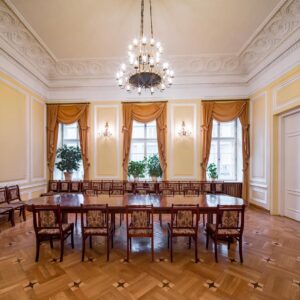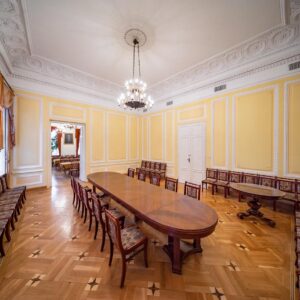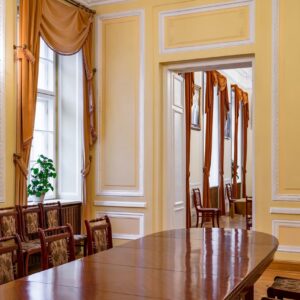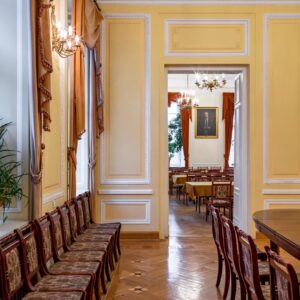- Wi-Fi
- Free-standing screen
- Flipchart
- 380V connection
- Laptop
- 55” TV
- Local (interroom) transmission
- Online streaming
- Number of seats – theater setting: 40
- Number of seats – oval table setting: 20
- Possibility to organize a secretariat in the lobby: yes
- Possibility to organize a buffet around the room: yes
- Possibility to arrange an exhibition space: yes
- View from the windows onto the west and the Zamoyski Palace
The Hugo Kołłątaj Hall can be found on the second floor of the palace, in the western part of the historic building complex. It is a small room, perfect for small-scale events such as meetings with authors, workshops, or plenary sessions. The adjacent space in the corridor section, separated by a counter, provides ideal conditions for a publishing stand and other event-related activities. The hall has an oval table for twenty meeting participants, and, optionally, may be set up as a theater with forty seats. The room may also serve as an exhibition space or a place for activities related to events held in the adjacent Stanisław Staszic Hall, connected with the Hugo Kołłątaj Hall by a direct internal passage. The Hugo Kołłątaj Hall is furnished with multimedia equipment. The hall stylistics relates to Corazzian neoclassicism, the original look of the palace.
In the place where the hall is found today, there used to be a library of foreign language periodicals in the times of the Warsaw Society of the Friends of Learning. Nature and mineralogical exhibits were presented in the corridor adjacent to the rooms in this part of the building. The layout of the interiors changed in the course of architectural alterations.
The decisions made by Piotr Biegański during the restoration (1940s) brought new solutions in terms of communication space; a corridor connecting this room with the passage in front of the Hall of Mirrors was built. The interior arrangement that has survived to the present day was also laid out.
The naming of one of the the Staszic Palace rooms after Hugo Kołłątaj goes much further than a mere association with the commemorated individual. In this instance, Kołłątaj becomes a symbolic figure, a representative of an important trend; educational activity. The Warsaw Society of the Friends of Learning was founded to become an institution bringing together representatives of diverse fields of study, generations, beliefs, and political views. Both in the past and at present, the space of the the Staszic Palace is an area of a broadly defined movement; an intellectual movement present in interdisciplinary, international and intergenerational activity. This kind of activity can also be found in the specific flow of scientific knowledge, generated and promoted in the institutes and departments by initiatives such as Festivals of Science, Archives Picnics, open lectures, Museum Nights, and above all, research culminating in dictionaries, textbooks, and books, providing the basic tools for university lecturers.
Aleksandra Wójtowicz



